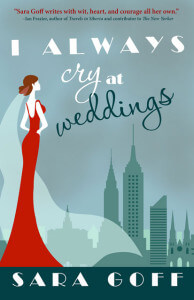 Our thanks to author Sara Goff for this guest post!
Our thanks to author Sara Goff for this guest post!
Readers aren’t likely to get excited about a death scene. You’re asking them to experience the protagonist’s despair, guilt-ridden relief, or callous pleasure, if that’s your story.
The scene is intrinsically heavy. The action likely slows down, and perhaps worst of all, we’re reminded of our own mortality. Basically, you’re entering dangerous storytelling territory, where your readers might skim, skip, or ‘kill’ the book right there, setting it down.
Losing a reader is a death no writer wants. You want to give your readers an emotional experience, and in order to get them laughing, bawling, or afraid to turn the next page they need to be engaged.
Here are four tips to writing a death scene that will lead your readers further (deeper) into the story:
Purpose.
Think of the sequential scenes or chapters in your story as drivers on a long and winding journey. Each driver, or scene, takes the wheel of your story for a leg of the trip. If one scene gets lost, moves too slowly, or (yikes!) pulls into a rest stop, the action brakes, along with your readers’ attention.
How to avoid this? Make sure each scene has its driver’s license. That is, each scene or chapter needs to have a specific purpose that moves the action forward. So, in writing a death scene, for example, ask yourself: Is the death necessary in order to reach your destination?
Here’s another way to phrase the question: Will arriving at “The End” feel incomplete or less satisfying without the scene?
If you answer “yes” to these questions, then hand over the keys and let that scene drive the action. My next three tips will test its driving skills.
Conflict.
 You’ve written a death scene and it’s licensed with big-picture purpose, advancing the plot. But does it have conflict? That’s like saying, is it fueled up for the drive?
You’ve written a death scene and it’s licensed with big-picture purpose, advancing the plot. But does it have conflict? That’s like saying, is it fueled up for the drive?
Readers are greedy; they expect the thrill of finding out what happens in every chapter, not just at the end of the book. A mistake I made when first writing about death was thinking, with unquestioning certainty, that the death of a supporting character was plenty of action to sustain a chapter.
After all, death is a major life event. Actually, death is not a major life event in storytelling unless it’s about to happen to your protagonist and she narrowly escapes. My focus was on the dying character, not on my protagonist, so the chapter stalled.
Your protagonist needs to take action, and the fact that she’s in dire despair over the death of her husband is a reaction, not an action. Where is the Conflict? How will it resolve?
Perhaps there’s a disagreement between your protagonist and her husband’s family, a disagreement that could make her lose custody of their daughter. Or the funeral home catches on fire and your protagonist risks her life to save her husband’s body. Well, you get the idea.
The conflict can be internal, as well. Your protagonist might be so terrified of losing her husband that she can’t find the words to say good-bye. Or she might be too proud to say she’s sorry for past mistakes and will have to live with the guilt. Now you have a purposeful chapter to the story as a whole that is also interesting on its own. A cliffhanger at the end of the chapter will keep your readers wanting more while you switch drivers, moving on to the next scene.
Originality.
My third tip is how to avoid writing a death scene that reads like every other death scene. Since most people have lost a loved one or attended a funeral, it’s important to personalize your scene.
Use props that mean something to your characters; for example, an old fiddle or a photograph. Color the room with flowers, curtains, a favorite pillow. A startling lack of color would also create a memorable scene, but be aware that you’re making a dark scene even darker. Unusual clothing and unexpected gifts would help to develop your characters. If a particular item, a keepsake, for example, is mentioned earlier in the story, now would be a good time to bring it back. In life we hang on to sentimental possessions when we’re feeling emotionally challenged; keep your story true to life.
Your chapter has Purpose, the right to belong in the story. It has Conflict, the gas to keep it going. You’ve even seasoned it with a unique blend of sensory objects that bring the action to life. However, you’re not done yet. There’s one more tip I can give you to deliver a death scene your readers will love.
Do not let a single cliché slip into the scene.
“Tears streamed down her cheeks.”
“It was his time to go.”
“This too shall pass.”
“The tragedy was too much to bear.”
I could go on and on. Think of clichés as road bumps. If your readers come across one, they’ll be reminded of the thousand times they’ve heard the phrase before. What happens then? They stumble over the sentence and lose the flow of the story. Be on high alert and take the time to give your characters their own thoughts.
Showing the death of a character or the subsequent funeral will challenge you as a writer and enhance your story on many levels. Losing a friend or family member can be a life-altering event, which might take your story in a new direction. Everyone handles death differently, which means you have an opportunity to show more about your characters’ personalities.
Most importantly, death gives you the chance to prove love’s everlasting power. With careful thought and attention to details, your scene will give the story emotional depth and resonate with readers.

 Sara Goff is the author of I Always Cry at Weddings and the founder of the global educational charity Lift the Lid, Inc., a non-profit supporting underprivileged schools and encouraging young people to exercise their creative expression through writing. Proceeds from the book will go towards her charity Lift the Lid, a 501(c)(3) tax-exempt organization. Visit www.lift-the-lid.org for more information on the charity.
Sara Goff is the author of I Always Cry at Weddings and the founder of the global educational charity Lift the Lid, Inc., a non-profit supporting underprivileged schools and encouraging young people to exercise their creative expression through writing. Proceeds from the book will go towards her charity Lift the Lid, a 501(c)(3) tax-exempt organization. Visit www.lift-the-lid.org for more information on the charity.

Sara,
Thanks for these great tips on writing compelling death scenes that avoid the obvious, the usual, and the cliches.
This is coming at a perfect time for writers who are gearing up to participate in National Novel Writing Month.
Ah, great point, Flora — Just 10 days to NaNoWriMo kickoff!!!
Every successful writer understands more than beginning writers and they seem to look for explicit pointers, more advanced writers will sense what the better writer mean by reading between the lines.
Thank you for these pointers and the ones you included between the lines.
Thanks, Merlin – agreed!
Merlin, I’m glad my tips are helpful, and I hope they save you a few rewrites. I struggled for years with writing the death scene in my book…rewrite after rewrite. Eventually, I got it right!